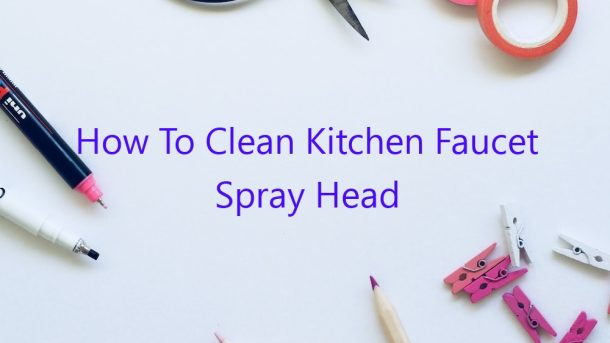A kitchen faucet spray head is one of the most important parts of a kitchen faucet. It is responsible for the water’s pressure and direction. Over time, the spray head can become clogged with minerals and sediment, which can affect the water’s pressure and flow. It is important to clean the spray head on a regular basis to ensure that your kitchen faucet operates at its best.
There are a few ways to clean a kitchen faucet spray head. One way is to use a vinegar and water solution. Pour 1 cup of vinegar into a bowl, and then place the spray head in the bowl. Soak the spray head in the vinegar for 30 minutes. Then, rinse the spray head with water and allow it to air dry.
Another way to clean a kitchen faucet spray head is to use a toothbrush. Soak the toothbrush in vinegar, and then scrub the spray head with the toothbrush. Rinse the spray head with water and allow it to air dry.
A third way to clean a kitchen faucet spray head is to use a dishwasher detergent tablet. Drop a dishwasher detergent tablet into a bowl of water, and then place the spray head in the bowl. Soak the spray head in the water for 30 minutes. Then, rinse the spray head with water and allow it to air dry.
No matter which method you choose, it is important to clean your kitchen faucet spray head on a regular basis to ensure that your kitchen faucet operates at its best.”
Contents [hide]
How do I clean the spray nozzle on my kitchen faucet?
The spray nozzle on your kitchen faucet can become dirty over time and needs to be cleaned regularly in order to function properly. Here is a simple guide on how to clean your spray nozzle:
First, remove the spray nozzle from the faucet. Some nozzles can be unscrewed by hand, while others may require a wrench.
Next, fill a small bowl with warm water and add a few drops of dish detergent.
Submerge the spray nozzle in the soapy water and use a toothbrush to scrub away any dirt or build-up.
Rinse the nozzle under warm water until it is clean.
Reattach the nozzle to the faucet and test it by spraying water.
If the spray nozzle is still not functioning properly, you may need to replace it.
How do you deep clean a kitchen faucet head?
It’s important to deep clean your kitchen faucet head on a regular basis to prevent the build-up of gunk and bacteria. Here’s how to do it:
1. Remove the faucet head by unscrewing it from the spout.
2. Soak the head in a bowl of hot, soapy water for 10-15 minutes.
3. Rinse the head thoroughly and reattach it to the spout.
4. Turn on the faucet and check for leaks.
If your faucet head is severely gunked-up, you may need to use a toothbrush or a scrub brush to get it clean.
How do you clean sink sprayer buildup?
Sink sprayers are a convenient way to quickly rinse dishes and other items. However, over time they can become clogged with mineral buildup and other debris. If not cleaned on a regular basis, this can lead to decreased performance and even a breakdown of the sprayer. Luckily, cleaning a sink sprayer is a fairly easy process.
The first step is to remove the sprayer from the sink. Depending on the model, this may be done by twisting it off or by pulling it up and out. If the latter, be sure to release the water pressure by pressing the button on the top of the sprayer.
Next, use a small brush or a toothpick to remove any built-up debris from the sprayer. Be sure to clean all of the openings, including the ones that the water comes out of.
Once the debris has been removed, rinse the sprayer with hot water. This will help remove any remaining build-up and will also help disinfect it.
Finally, reattach the sprayer to the sink and test it out. If it doesn’t seem to be working properly, you may need to follow the same steps to clean the sink’s sprayer hose.
How do you clean buildup on faucet heads?
Most people don’t think about the faucet heads in their home until they start to get clogged with mineral buildup and start to produce less water pressure. Cleaning the faucet heads is a quick and easy way to improve the water pressure in your home without having to call a plumber.
The first step is to remove the faucet head from the faucet. This can be done by unscrewing it or by pulling it off. Once the faucet head is off, you will need to soak it in a vinegar or bleach solution. You can either mix the vinegar or bleach with water or you can soak the faucet head in a bowl or pot of vinegar or bleach.
After the faucet head has been soaking in the vinegar or bleach solution for a few minutes, you will need to scrub it with a brush. Be sure to scrub all of the build-up off of the faucet head. Once it is clean, you can put it back on the faucet and screw it back in place.
If you have a lot of mineral build-up on your faucet heads, you may need to repeat this process a few times. But, once the build-up is gone, you should not have to clean the faucet heads again for a while.
Will vinegar damage finish on faucet?
There is some debate over whether vinegar will damage the finish on a faucet. Some say that vinegar is a gentle cleaner that will not harm the finish, while others maintain that vinegar can damage the finish, causing it to become dull or even peel.
If you are unsure whether vinegar will damage the finish on your faucet, it is best to test it in a small, inconspicuous area before using it on the entire faucet. If the vinegar does damage the finish, you can try using a mild detergent or a commercial faucet cleaner.
How do you clean a Moen kitchen faucet spray head?
A Moen kitchen faucet spray head is a great way to clean dishes and utensils. Over time, however, the spray head can become clogged with food and other debris. If this happens, it can be difficult to get the spray head to work properly. Fortunately, cleaning a Moen kitchen faucet spray head is a relatively simple process.
The first step is to identify the type of spray head that is installed on your kitchen faucet. There are two types: a toggle switch spray head and a side sprayer.
The toggle switch spray head is the most common type. It has two buttons: a spray and a stream. To clean the toggle switch spray head, you will need to remove it from the faucet.
The side sprayer is installed on the side of the faucet and has a hose that extends down into the sink. To clean the side sprayer, you will need to remove the hose from the faucet and soak it in a vinegar and water solution.
Once you have identified the type of spray head that is installed on your kitchen faucet, you can begin the cleaning process.
If the spray head is installed on the faucet, you will need to remove it. To do this, you will need to use a wrench to loosen the hose clamp. Once the hose clamp is loose, you can remove the spray head from the faucet.
If the spray head is installed on the hose, you will need to remove the hose from the faucet. To do this, you will need to use a wrench to loosen the hose clamp. Once the hose clamp is loose, you can remove the hose from the faucet.
Once the spray head is removed, you can clean it with a brush or a toothpick. If the spray head is clogged with food or other debris, this will help to remove it.
Once the spray head is clean, you can reattach it to the faucet or hose. If the spray head is attached to the faucet, you will need to tighten the hose clamp with a wrench. If the spray head is attached to the hose, you will need to reattach the hose to the faucet and tighten the hose clamp with a wrench.
Once the spray head is attached, you can test it to make sure it is working properly. To do this, you will need to turn on the water and press the spray or stream button. If the spray head is working properly, you should be able to see a stream of water coming out of the nozzle.
If the spray head is not working properly, you may need to replace it. To do this, you will need to remove the spray head from the faucet or hose and take it to a hardware store or plumbing supply store. There, you can purchase a new spray head that is compatible with your kitchen faucet.
Is CLR better than vinegar?
Is CLR better than vinegar?
There are many different types of vinegar on the market, but which one is the best for cleaning? Vinegar is a great all-purpose cleaner, but there are different types of vinegar that can be used for different purposes.
CLR is a product that is made to clean calcium, lime, and rust build-up. It is a liquid that comes in a spray bottle and is supposed to be sprayed on the area that needs to be cleaned and then wiped off. Vinegar is also a great cleaner, and it comes in different strengths. White vinegar is the weakest and can be used to clean a variety of things. Apple cider vinegar is a little bit stronger and can be used to clean tougher surfaces.
Both CLR and vinegar can be used to clean toilets. CLR is a little bit more expensive than vinegar, but it is supposed to be a stronger cleaner. Vinegar is a great cleaner and is cheaper than CLR, but it may not be as strong.




